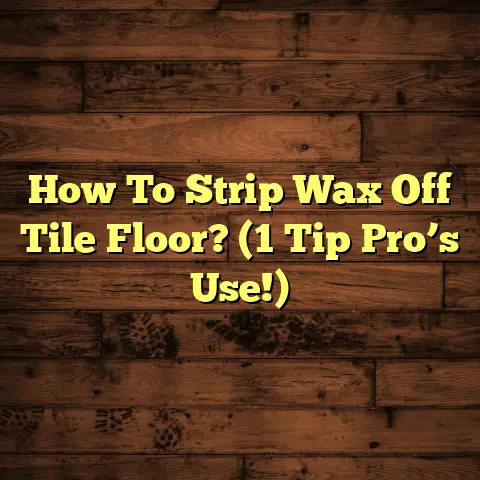Cheap VCT Floor Tiles: Affordable? (4 Install Fails!)
Did you know that choosing cheap VCT floor tiles could end up costing you more in the long run than investing in higher-quality options? I’ve seen it happen time and again. Let’s dive into why that initial “bargain” can quickly turn into a flooring nightmare.
Understanding VCT Floor Tiles
So, what exactly are VCT floor tiles?
VCT stands for Vinyl Composition Tile. They’re made from a mixture of polyvinyl chloride resins, plasticizers, limestone, pigments, and a binder.
Think of it as a blend of materials compressed into a solid tile.
They’re commonly used in high-traffic areas like schools, hospitals, and grocery stores because of their durability and relatively low cost.
The appeal is simple: they’re affordable, come in a wide range of colors and patterns, and are generally easy to maintain.
You can find VCT that mimics everything from stone to abstract designs, and a simple damp mop usually keeps them clean.
VCT has been a staple in both residential and commercial spaces for decades.
While other flooring options like LVP (Luxury Vinyl Plank) and ceramic tile have gained popularity, VCT remains a budget-friendly contender, especially in commercial settings.
The Allure of Cheap VCT Tiles
Why are people drawn to the cheaper VCT options? Let’s break it down:
Cost Savings
This is the big one. The initial price point of cheap VCT is undeniably attractive.
You might see prices as low as $0.50 per square foot for budget VCT, compared to $2-$5 per square foot for higher-quality options or other flooring types.
That difference can add up significantly, especially in large areas.
Aesthetic Variety
Even at a lower price point, you can still find a decent selection of colors and styles.
Cheap VCT often comes in basic solid colors or simple patterns, allowing for some design flexibility without breaking the bank.
Accessibility
You can find cheap VCT tiles at almost any home improvement store or online retailer.
This widespread availability makes them a convenient choice for DIYers or contractors looking for a quick and easy solution.
The Hidden Costs of Cheap VCT Tiles
Here’s where things get interesting. That initial low price can be deceptive.
There are often hidden costs associated with cheaper flooring options that can quickly erode any initial savings.
Shorter Lifespan Leading to Frequent Replacements
Cheap VCT is, well, cheap for a reason.
It’s often made with lower-quality materials and less durable construction.
This means it’s more susceptible to scratches, dents, and general wear and tear.
I’ve seen cheap VCT start to show significant wear within just a few years, requiring replacement much sooner than a higher-quality floor.
According to industry data, a good quality VCT floor can last 10-20 years with proper maintenance, while a cheaper option might only last 3-7 years.
Increased Maintenance Costs Due to Wear and Tear
Because cheap VCT is more prone to damage, it often requires more frequent and intensive maintenance.
This could include more frequent stripping and waxing, specialized cleaning products, or even professional repairs.
These ongoing costs can quickly add up, negating any initial savings.
Potential for Injury or Damage Due to Poor Quality
Low-quality VCT can sometimes be more slippery than higher-quality options, especially when wet.
This can increase the risk of slips and falls, leading to potential injuries and liability.
Additionally, if the tiles are poorly installed or become damaged, they can create tripping hazards.
Common Installation Fails
Now, let’s get to the heart of the matter: the installation fails that can plague cheap VCT.
These are the mistakes I’ve seen firsthand that turn a budget-friendly project into a costly headache.
Fail 1: Improper Surface Preparation
This is the foundation of any successful flooring installation, and it’s often where things go wrong with cheap VCT.
The Importance of a Level, Clean Substrate
VCT requires a perfectly level, clean, and dry surface to adhere properly.
Any imperfections in the subfloor, such as cracks, bumps, or debris, will telegraph through the VCT and can cause the tiles to lift, crack, or wear unevenly.
The Pitfalls of Neglecting This Step
I once worked on a project where the client insisted on installing cheap VCT directly over an old, uneven concrete floor.
Despite my warnings, they proceeded without properly leveling the surface.
Within months, the tiles started to crack and lift in several areas, creating a patchwork of damage.
They ended up having to tear out the entire floor and start over, costing them far more than if they had invested in proper surface preparation in the first place.
Anecdote
I had a customer who tried to install VCT over old linoleum. Big mistake.
The old linoleum wasn’t properly bonded to the subfloor, and it had years of grime embedded in it.
The VCT adhesive couldn’t properly bond, and the whole floor started peeling up within a few weeks.
They had to rip it all out, properly prep the floor, and start over.
Fail 2: Inadequate Adhesive Application
Adhesive is the glue that holds everything together, and using the wrong type or not enough of it can lead to disaster.
The Role of Adhesive in VCT Installation
The adhesive creates a bond between the VCT tile and the subfloor, ensuring that the tile stays securely in place.
Using the wrong type of adhesive or applying it incorrectly can result in tiles lifting, curling, or shifting over time.
Consequences of Improper Adhesive Choices
I’ve seen instances where contractors tried to save money by using a generic construction adhesive instead of a VCT-specific adhesive.
This resulted in a weak bond that failed within a few months, causing the tiles to lift and curl at the edges.
Anecdote
One time, I saw a DIYer try to install VCT with double-sided tape. I kid you not.
They thought it would be a quick and easy solution. Needless to say, it didn’t work.
The tiles started sliding around within days, and the whole floor was a mess.
They learned the hard way that you need the right adhesive for the job.
Fail 3: Incorrect Layout and Alignment
Proper layout planning is crucial for achieving a professional-looking and structurally sound VCT floor.
The Impact of Poor Layout Planning
If the layout is not carefully planned, you can end up with awkward cuts, uneven borders, and misaligned tiles.
This not only looks bad but can also weaken the floor’s overall integrity.
Real-Life Examples of Misalignment
I’ve seen installations where the tiles were laid out without considering the room’s geometry, resulting in a noticeable slant across the floor.
This not only looked unprofessional but also made it difficult to place furniture evenly.
Anecdote
I had a job where the original installer didn’t center the layout in the room.
They started at one wall and just kept laying tiles. By the time they got to the opposite wall, the tiles were cut into tiny, uneven slivers.
It looked terrible and was a pain to fix.
Fail 4: Ignoring Environmental Conditions
Temperature and humidity can significantly affect the installation and longevity of VCT.
How Temperature and Humidity Affect VCT
VCT tiles expand and contract with changes in temperature and humidity.
If the tiles are installed in conditions that are too hot, cold, or humid, they can expand or contract excessively, leading to buckling, cracking, or adhesive failure.
Scenarios Where Ignoring Environmental Factors Led to Failures
I’ve seen cases where VCT was installed in a warehouse during the winter months without allowing the tiles to acclimate to the indoor temperature.
As the temperature warmed up in the spring, the tiles expanded and buckled, requiring extensive repairs.
Anecdote
I once worked on a job in a basement that was prone to moisture. The homeowner installed VCT without addressing the moisture problem first.
Within a year, the tiles started to lift and mold started growing underneath.
The whole floor had to be torn out and the moisture issue resolved before a new floor could be installed.
Conclusion
So, are cheap VCT floor tiles really affordable? The answer is: it depends.
While the initial price point may be attractive, the potential for hidden costs and installation failures can quickly erode any savings.
Summarizing the Pitfalls
From improper surface preparation to inadequate adhesive application, incorrect layout, and ignoring environmental conditions, there are many ways that a cheap VCT installation can go wrong.
These failures can lead to costly repairs, premature replacements, and even potential safety hazards.
A Final Thought
In the quest for savings, how much are you really willing to risk? Sometimes, investing a little more upfront in higher-quality materials and professional installation can save you a lot of money and headaches in the long run.
Don’t let a seemingly good deal blind you to the potential pitfalls. Do your research, ask questions, and make an informed decision that will give you a beautiful and durable floor for years to come.





